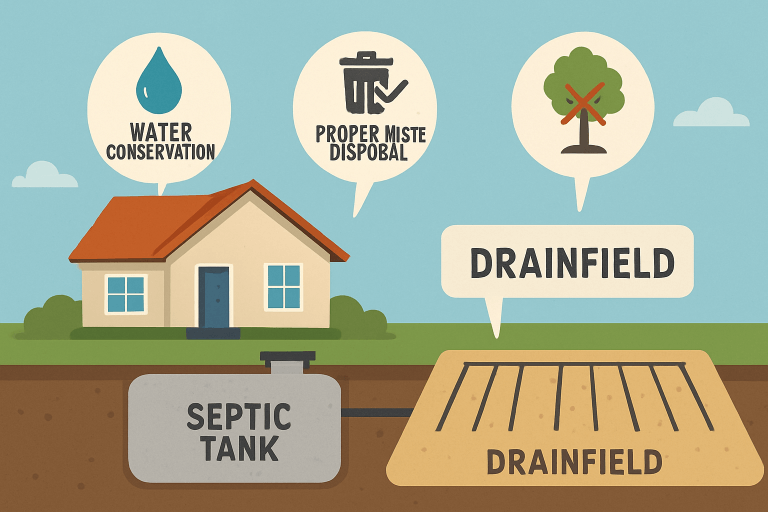Septic Tank Maintenance Tips for Homeowners

Owning a home with a septic tank system comes with responsibilities that can’t be overlooked, especially regarding maintenance. Unlike municipal sewer systems, septic tanks require routine care to prevent costly backups, unpleasant odors, or environmental damage. Knowing what to do—and what to avoid—can help extend the life of your system and ensure it functions efficiently for years to come. From pumping schedules to everyday best practices, this guide offers essential tips every homeowner should know to keep their septic system in shape.
Maintaining your septic system is essential not only to avoid expensive emergency repairs but also to ensure the long-term health of your property. Regular attention helps prevent unpleasant backups, protects the environment, and safeguards your investment. For those in the Midwest, scheduling periodic septic tank pumping Dayton, Ohio is a critical step in this ongoing home maintenance. Following a few fundamental practices can keep your septic system running efficiently for years. This comprehensive guide covers the essential maintenance tips every homeowner should know, from routine inspections to protecting your drainfield and adopting septic-safe habits.
Table of Contents
Schedule Regular Inspections and Pumping
One of the most effective ways to prevent septic system malfunctions is routine inspection and pumping. The U.S. Environmental Protection Agency (EPA) recommends professional inspections every three years and regular pumping every three to five years—specific intervals may depend on household size and usage patterns. Inspections help identify minor issues and timely pumping removes accumulated solids that otherwise pose a risk of backing up into your home or clogging the drainfield. Ignoring this step may shorten your system’s lifespan and require costly repairs.
Conserve Water to Reduce System Strain
Efficient water use plays a significant role in extending your septic system’s life. Excessive water output—such as from long showers, multiple back-to-back laundry loads, or plumbing leaks—can overwhelm the tank and disrupt the natural treatment process. Address leaks quickly, install low-flow fixtures, and spread out high-water-use activities. These simple changes reduce the risk of wastewater escaping before solids are properly treated.
Dispose of Waste Properly
Everything you flush or pour down your drains impacts the septic system. Avoid sending non-biodegradable items—like disposable wipes, cotton swabs, feminine hygiene products, or even paper towels—through toilets or sinks. Household chemicals, fats, oils, and grease can cause blockages and kill the beneficial bacteria that decompose waste in your tank. Rely on toilet paper labeled as septic-safe, and dispose of hazardous materials and regulations to prevent damage and keep your system healthy.
Protect Your Drainfield
Prevent Soil Compaction and Saturation
The drainfield is a pivotal area in the wastewater treatment cycle. Parking vehicles or storing heavy equipment on the drainfield can compact the soil and damage underground pipes, limiting the area’s ability to absorb and filter wastewater effectively. Additionally, aim to direct excess water—such as from roof gutters, sump pumps, or outdoor runoff—away from the drainfield to avoid oversaturation, which impedes natural filtration and increases the risk of flooding.
Manage Landscaping Near the Drainfield
Be strategic with landscaping. Large trees and shrubs planted too close to the drainfield can send invasive roots into pipes, causing blockages and costly repairs. Opt for grass or shallow-rooted plants near this critical area to reduce root intrusion risk and maintain proper system functioning.
Use Septic-Safe Products
The balance of bacteria in septic tank is crucial for breaking down waste. Many household cleaners and harsh chemicals can disrupt this biological ecosystem, reducing system efficiency and potentially leading to costly repairs. Choose biodegradable and non-toxic cleaning products labeled as septic-safe, and limit use of bleach, antibacterial soaps, and solvents to help support the living organisms in your tank.
See also: Creative Ways to Increase Home Value Before Selling
Monitor Household Water Usage
Beyond daily conservation, monitoring water usage can prevent unnecessary strain on your septic system. Check for dripping faucets or running toilets, and repair any leaks promptly. Use water-efficient appliances, further limit the volume entering your system. Plan high-water-use activities—like laundry and dishwashing—across the week rather than all at once for optimal system performance.
Educate Household Members
Effective septic system care requires everyone in your household to follow best practices. Educate family members about what can safely go down drains and the reasons behind conserving water. Encourage proper waste disposal, mindful use of cleaning products, and respect for the drain field area. An informed household reduces the risk of accidental damage and extends the life of your septic system.
Keep Maintenance Records
Maintain a log of all inspections, pumping appointments, repairs, and any issues you encounter. These records provide valuable insight for technicians, help track system health over time, and ensure you stay current with necessary maintenance. Reliable documentation can even be useful if you sell your home, as it demonstrates diligence in property upkeep.
Taking a proactive approach to septic tank maintenance saves money, avoids emergency repairs, and protects both your property and the local environment. Consistent care, mindful water use, and good waste disposal habits keep systems operating efficiently for decades.



